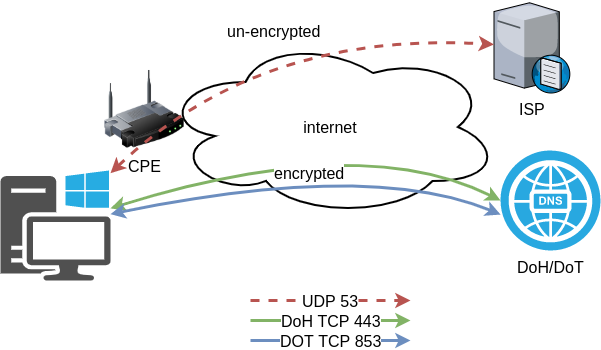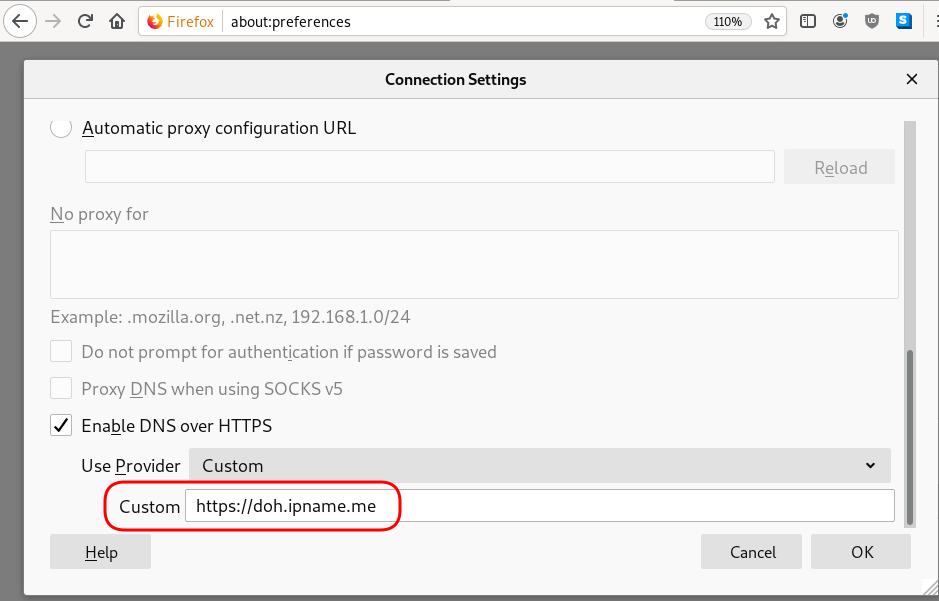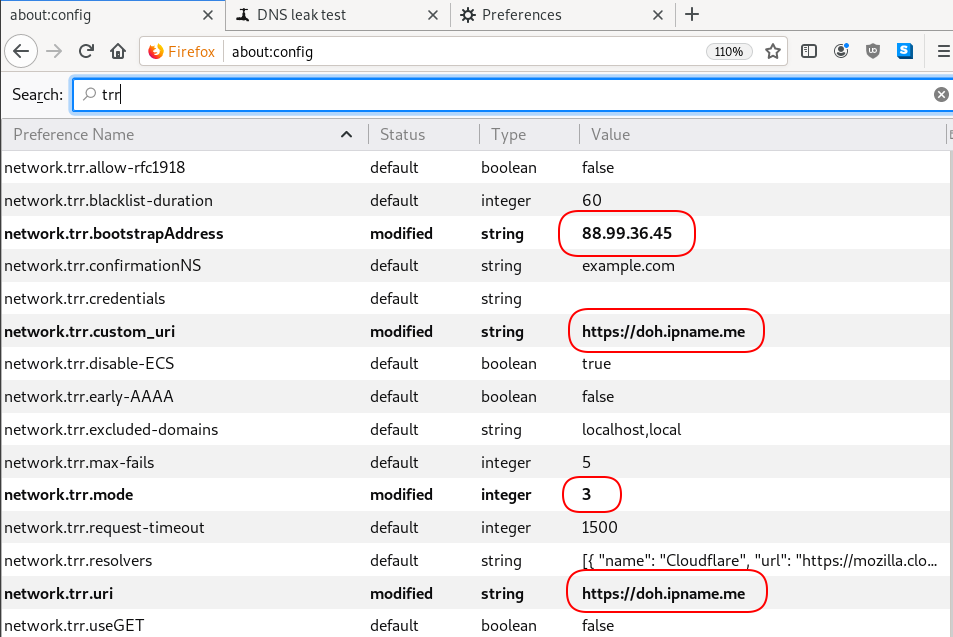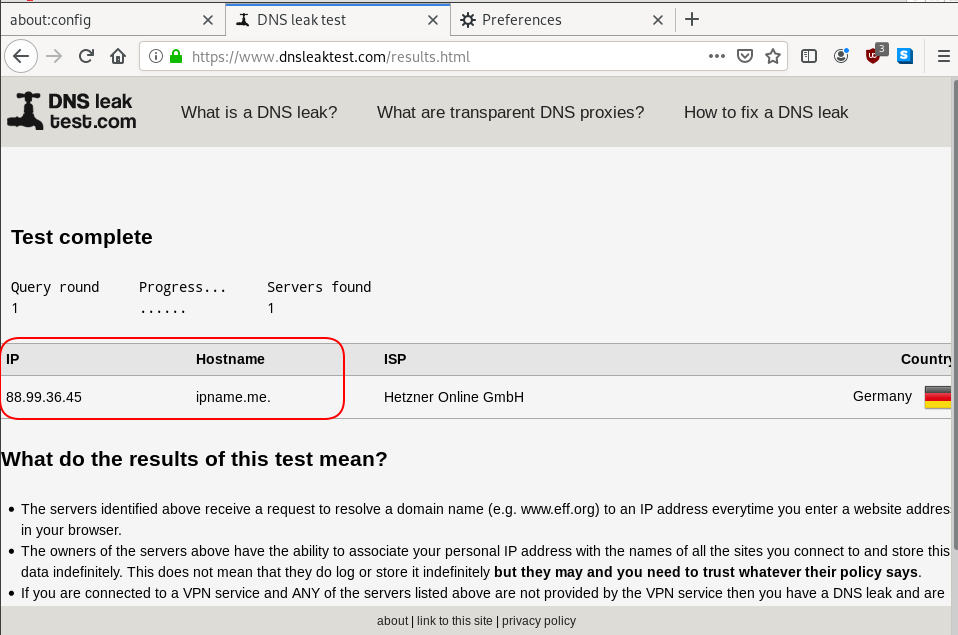I upgraded my home internet connection and as a result I had to give up my ~15y Static IP. Having an ephemeral Dynamic IP means I need to use a dynamic dns service to access my homepc. Although the ISP’s CPE (router) has a few public dynamic dns services, I chose to create a simple solution on my own self-hosted DNS infra.
There are a couple of ways to do that, PowerDNS supports Dynamic Updates but I do not want to open PowerDNS to the internet for this kind of operations. I just want to use cron with a simple curl over https.
PowerDNS WebAPI
to enable and use the Built-in Webserver and HTTP API we need to update our configuration:
/etc/pdns/pdns.conf
api-key=0123456789ABCDEF
api=yesand restart powerdns auth server.
verify it
ss -tnl 'sport = :8081'State Recv-Q Send-Q Local Address:Port Peer Address:Port
LISTEN 0 10 127.0.0.1:8081 *:*
WebServer API in PHP
Next to build our API in PHP
Basic Auth
By using https means that the transport layer is encrypted so we only need to create a basic auth mechanism.
<?php
if ( !isset($_SERVER["PHP_AUTH_USER"]) ) {
header("WWW-Authenticate: Basic realm='My Realm'");
header("HTTP/1.0 401 Unauthorized");
echo "Restricted area: Only Authorized Personnel Are Allowed to Enter This Area";
exit;
} else {
// code goes here
}
?>by sending Basic Auth headers, the _SERVER php array variable will contain two extra variables
$_SERVER["PHP_AUTH_USER"]
$_SERVER["PHP_AUTH_PW"]We do not need to setup an external IDM/LDAP or any other user management system just for this usecase (single user access).
and we can use something like:
<?php
if (($_SERVER["PHP_AUTH_USER"] == "username") && ($_SERVER["PHP_AUTH_PW"] == "very_secret_password")){
// code goes here
}
?>RRSet Object
We need to create the RRSet Object
here is a simple example
<?php
$comments = array(
);
$record = array(
array(
"disabled" => False,
"content" => $_SERVER["REMOTE_ADDR"]
)
);
$rrsets = array(
array(
"name" => "dyndns.example.org.",
"type" => "A",
"ttl" => 60,
"changetype" => "REPLACE",
"records" => $record,
"comments" => $comments
)
);
$data = array (
"rrsets" => $rrsets
);
?>by running this data set to json_encode should return something like this
{
"rrsets": [
{
"changetype": "REPLACE",
"comments": [],
"name": "dyndns.example.org.",
"records": [
{
"content": "1.2.3.4",
"disabled": false
}
],
"ttl": 60,
"type": "A"
}
]
}be sure to verify that records, comments and rrsets are also arrays !
Stream Context
Next thing to create our stream context
$API_TOKEN = "0123456789ABCDEF";
$URL = "http://127.0.0.1:8081/api/v1/servers/localhost/zones/example.org";
$stream_options = array(
"http" => array(
"method" => "PATCH",
"header" => "Content-type: application/json \r\n" .
"X-API-Key: $API_TOKEN",
"content" => json_encode($data),
"timeout" => 3
)
);
$context = stream_context_create($stream_options);
Be aware of " \r\n" . in header field, this took me more time than it should ! To have multiple header fiels into the http stream, you need (I don’t know why) to carriage return them.
Get Zone details
Before continue, let’s make a small script to verify that we can successfully talk to the PowerDNS HTTP API with php
<?php
$API_TOKEN = "0123456789ABCDEF";
$URL = "http://127.0.0.1:8081/api/v1/servers/localhost/zones/example.org";
$stream_options = array(
"http" => array(
"method" => "GET",
"header" => "Content-type: application/jsonrn".
"X-API-Key: $API_TOKEN"
)
);
$context = stream_context_create($stream_options);
echo file_get_contents($URL, false, $context);
?>by running this:
php get.php | jq .we should get the records of our zone in json format.
Cron Entry
you should be able to put the entire codebase together by now, so let’s work on the last component of our self-hosted dynamic dns server, how to update our record via curl
curl -sL https://username:very_secret_password@example.org/dyndns.phpevery minute should do the trick
# dyndns
* * * * * curl -sL https://username:very_secret_password@example.org/dyndns.php
That’s it !
In this blog post I will describe the easiest installation of a DoH/DoT VM for personal use, using dnsdist.
Next I will present a full installation example (from start) with dnsdist and PowerDNS.
Server Notes: Ubuntu 18.04
Client Notes: ArchlinuxEvery
{{ }}is a variable you need to change.
Do NOT copy/paste without making the changes.

Login to VM
and became root
$ ssh {{ VM }}
$ sudo -ifrom now on, we are running commands as root.
TLDR;
dnsdist DoH/DoT
If you just need your own DoH and DoT instance, then dnsdist will forward your cleartext queries to another public DNS server with the below configuration.
cat > /etc/dnsdist/dnsdist.conf <<EOF
-- resets the list to this array
setACL("::/0")
addACL("0.0.0.0/0")
addDOHLocal('0.0.0.0', '/etc/dnsdist/fullchain.pem', '/etc/dnsdist/privkey.pem')
addTLSLocal('0.0.0.0', '/etc/dnsdist/fullchain.pem', '/etc/dnsdist/privkey.pem')
newServer({address="9.9.9.9:53"})
EOFYou will need -of course- to have your certificates before hand.
That’s It !
a DoH/DoT using dnsdist and powerdns
For people that need a more in-depth article, here are my notes on how to setup from scratch an entire VM with powerdns recursor and dnsdist.
Let’s Begin:
Enable PowerDNS Repos
Add key
curl -sL https://repo.powerdns.com/FD380FBB-pub.asc | apt-key add -
OKCreate PowerDNS source list
cat > /etc/apt/sources.list.d/powerdns.list <<EOF
deb [arch=amd64] http://repo.powerdns.com/ubuntu bionic-dnsdist-14 main
deb [arch=amd64] http://repo.powerdns.com/ubuntu bionic-rec-42 main
EOF
cat > /etc/apt/preferences.d/pdns <<EOF
Package: pdns-* dnsdist*
Pin: origin repo.powerdns.com
Pin-Priority: 600
EOFUpdate System and Install packages
apt-get update
apt-get -qy install dnsdist pdns-recursor certbotYou may see errors from powerdns, like
failed: E: Sub-process /usr/bin/dpkg returned an error code (1)ignore them for the time being.
PowerDNS Recursor
We are going to setup our recursor first and let’s make it a little interesting.
PowerDNS Configuration
cat > /etc/powerdns/recursor.conf <<EOF
config-dir=/etc/powerdns
hint-file=/etc/powerdns/root.hints
local-address=127.0.0.1
local-port=5353
lua-dns-script=/etc/powerdns/pdns.lua
etc-hosts-file=/etc/powerdns/hosts.txt
export-etc-hosts=on
quiet=yes
setgid=pdns
setuid=pdns
EOF
chmod 0644 /etc/powerdns/recursor.conf
chown pdns:pdns /etc/powerdns/recursor.confCreate a custom response
This will be handy for testing our dns from cli.
cat > /etc/powerdns/pdns.lua <<EOF
domainame = "test.{{ DOMAIN }}"
response = "{{ VM_ipv4.address }}"
function nxdomain(dq)
if dq.qname:equal(domainame) then
dq.rcode=0 -- make it a normal answer
dq:addAnswer(pdns.A, response)
dq.variable = true -- disable packet cache
return true
end
return false
end
EOF
chmod 0644 /etc/powerdns/pdns.lua
chown pdns:pdns /etc/powerdns/pdns.luaAdBlock
Let’s make it more interesting, block trackers and ads.
cat > /usr/local/bin/update.stevenBlack.hosts.sh <<EOF
#!/bin/bash
# Get StevenBlack hosts
curl -sLo /tmp/hosts.txt https://raw.githubusercontent.com/StevenBlack/hosts/master/hosts
touch /etc/powerdns/hosts.txt
# Get diff
diff -q <(sort -V /etc/powerdns/hosts.txt | column -t) <(sort -V /tmp/hosts.txt | column -t)
DIFF_STATUS=$?
# Get Lines
LINES=`grep -c ^ /tmp/hosts.txt`
# Check & restart if needed
if [ "${LINES}" -gt "200" -a "${DIFF_STATUS}" != "0" ]; then
mv -f /tmp/hosts.txt /etc/powerdns/hosts.txt
chmod 0644 /etc/powerdns/hosts.txt
chown pdns:pdns /etc/powerdns/hosts.txt
systemctl restart pdns-recursor
fi
# vim: sts=2 sw=2 ts=2 et
EOF
chmod +x /usr/local/bin/update.stevenBlack.hosts.sh
/usr/local/bin/update.stevenBlack.hosts.shBe Careful with Copy/Paste. Check the
$dollar sign.
OpenNic Project
Is it possible to make it more interesting ?
Yes! by using OpenNIC Project, instead of the default root NS
cat > /usr/local/bin/update.root.hints.sh <<EOF
#!/bin/bash
# Get root hints
dig . NS @75.127.96.89 | egrep -v '^;|^$' > /tmp/root.hints
touch /etc/powerdns/root.hints
# Get diff
diff -q <(sort -V /etc/powerdns/root.hints | column -t) <(sort -V /tmp/root.hints | column -t)
DIFF_STATUS=$?
# Get Lines
LINES=`grep -c ^ /tmp/root.hints`
# Check & restart if needed
if [ "${LINES}" -gt "20" -a "${DIFF_STATUS}" != "0" ]; then
mv -f /tmp/root.hints /etc/powerdns/root.hints
chmod 0644 /etc/powerdns/root.hints
chown pdns:pdns /etc/powerdns/root.hints
systemctl restart pdns-recursor
fi
# vim: sts=2 sw=2 ts=2 et
EOF
chmod +x /usr/local/bin/update.root.hints.sh
/usr/local/bin/update.root.hints.shdnsdist
dnsdist is a DNS load balancer with enhanced features.
dnsdist configuration
cat > /etc/dnsdist/dnsdist.conf <<EOF
-- resets the list to this array
setACL("::/0")
addACL("0.0.0.0/0")
addDOHLocal('0.0.0.0', '/etc/dnsdist/fullchain.pem', '/etc/dnsdist/privkey.pem')
addTLSLocal('0.0.0.0', '/etc/dnsdist/fullchain.pem', '/etc/dnsdist/privkey.pem')
newServer({address="127.0.0.1:5353"})
EOFCertbot
Now it is time to get a new certificate with the help of letsencrypt.
Replace
{{ DOMAIN }}with your domain
We need to create the post hook first and this is why we need to copy the certificates under dnsdist folder.
cat > /usr/local/bin/certbot_post_hook.sh <<EOF
#!/bin/bash
cp -f /etc/letsencrypt/live/{{ DOMAIN }}/*pem /etc/dnsdist/
systemctl restart dnsdist.service
# vim: sts=2 sw=2 ts=2 et
EOF
chmod +x /usr/local/bin/certbot_post_hook.shand of course create a certbot script.
Caveat: I have the dry-run option in the below script. When you are ready, remove it.
cat > /usr/local/bin/certbot.create.sh <<EOF
#!/bin/bash
certbot --dry-run --agree-tos --standalone certonly --register-unsafely-without-email
--pre-hook 'systemctl stop dnsdist'
--post-hook /usr/local/bin/certbot_post_hook.sh
-d {{ DOMAIN }} -d doh.{{ DOMAIN }} -d dot.{{ DOMAIN }}
# vim: sts=2 sw=2 ts=2 et
EOF
chmod +x /usr/local/bin/certbot.create.shFirewall
Now open your firewall to the below TCP Ports:
ufw allow 80/tcp
ufw allow 443/tcp
ufw allow 853/tcp- TCP 80 for certbot
- TCP 443 for dnsdist (DoT) and certbot !
- TCP 853 for dnsdist (DoH)
Let’s Encrypt
When you are ready, run the script
/usr/local/bin/certbot.create.shThat’s it !
Client
For this blog post, my test settings are:
Domain: ipname.me
IP: 88.99.36.45
DoT - Client
From systemd 243+ there is an option to validate certificates on DoT but
systemd-resolved only validates the DNS server certificate if it is issued for the server’s IP address (a rare occurrence).
so it is best to use: opportunistic
/etc/systemd/resolved.conf [Resolve]
DNS=88.99.36.45
FallbackDNS=1.1.1.1
DNSSEC=no
#DNSOverTLS=yes
DNSOverTLS=opportunistic
Cache=yes
ReadEtcHosts=yessystemctl restart systemd-resolved
Query
resolvectl query test.ipname.me test.ipname.me: 88.99.36.45 -- link: eth0
-- Information acquired via protocol DNS in 1.9ms.
-- Data is authenticated: noDoH - Client
Firefox Settings

Firefox TRR

dnsleak
Click on DNS leak test site to verify

Domain Name Service Response Policy Zones
from PowerDNS Recursor documentation :
Response Policy Zone is an open standard developed by Paul Vixie (ISC and Farsight) and Vernon Schryver (Rhyolite), to modify DNS responses based on a policy loaded via a zonefile.
Sometimes it is called: DNS Firewall
Reading Material
aka useful links:
Scheme
An example scheme to get a a better understanding on the concept behind RPZ.

Purpose
The main purposes of implentanting DNS RPZ in your DNS Infrastructure are to dynamicaly DNS sinkhole:
- Malicious domains,
- Implement goverment regulations,
- Prevent users to visit domains that are blocked via legal reasons.
by maintaining a single RPZ zone (or many) or even getting a subscription from another cloud provider.
Althouth for SOHO enviroments I suggest reading this blog post: Removing Ads with your PowerDNS Resolver and customize it to your needs.
RPZ Policies
These are the RPZ Policies we can use with PowerDNS.
- Policy.Custom (default policy)
- Policy.Drop
- Policy.NXDOMAIN
- Policy.NODATA
- Policy.Truncate
- Policy.NoAction
Policy.Custom:
Will return a NoError, CNAME answer with the value specified with
defcontent, when looking up the result of this CNAME, RPZ is not taken into account
Use Case
Modify the DNS responces with a list of domains to a specific sinkhole dns record.
eg.
thisismytestdomain.com.org ---> sinkhole.example.net.
*.thisismytestdomain.com.org ---> sinkhole.example.net.
example.org ---> sinkhole.example.net.
*.example.org ---> sinkhole.example.net.
example.net ---> sinkhole.example.net.
*.example.net ---> sinkhole.example.net.DNS sinkhole record
Create an explicit record outside of the DNS RPZ scheme.
A type A Resource Record to a domain zone that points to 127.0.0.1 is okay, or use an explicit host file that the resolver can read. In the PowerDNS Recursor the configuration for this, are these two lines:
etc-hosts-file=/etc/pdns-recursor/hosts.blocked
export-etc-hosts=onthen
$ echo "127.0.0.5 sinkhole.example.net" >> /etc/pdns-recursor/hosts.blocked
and reload the service.
rpz.zone
RPZ functionality is set by reading a bind dns zone file, so create a simple file:
/etc/pdns-recursor/rpz.zone
; Time To Live
$TTL 86400
; Start Of Authorite
@ IN SOA authns.localhost. hostmaster. 2018042901 14400 7200 1209600 86400
; Declare Name Server
@ IN NS authns.localhost.Lua
RPZ support configuration is done via our Lua configuration mechanism
In the pdns-recursor configuration file: /etc/pdns-recursor/recursor.conf we need to declare a lua configuration file:
lua-config-file=/etc/pdns-recursor/rpz.luaLua-RPZ Configuration file
that points to the rpz.zone file. In this example, we will use Policy.Custom to send every DNS query to our default content: sinkhole.example.net
/etc/pdns-recursor/rpz.lua
rpzFile("/etc/pdns-recursor/rpz.zone", {defpol=Policy.Custom, defcontent="sinkhole.example.net."})Restart PowerDNS Recursor
At this moment, restart the powerdns recusor
# systemctl restart pdns-recursor
or
# service pdns-recursor restart
and watch for any error log.
Domains to sinkhole
Append to the rpz.zone all the domains you need to sinkhole. The defcontent="sinkhole.example.net." will ignore the content of the zone, but records must be valid, or else pdns-recursor will not read the rpz bind zone file.
; Time To Live
$TTL 86400
; Start Of Authorite
@ IN SOA authns.localhost. hostmaster. 2018042901 14400 7200 1209600 86400
; Declare Name Server
@ IN NS authns.localhost.
; Domains to sinkhole
thisisatestdomain.org. IN CNAME sinkhole.example.net.
thisisatestdomain.org. IN CNAME sinkhole.example.net.
example.org. IN CNAME sinkhole.example.net.
*.example.org. IN CNAME sinkhole.example.net.
example.net. IN CNAME sinkhole.example.net.
*.example.net. IN CNAME sinkhole.example.net.When finished, you can reload the lua configuration file that read the rpz.zone file, without restarting the powerdns recursor.
# rec_control reload-lua-config
Verify with dig
testing the dns results with dig:
$ dig example.net.
;; QUESTION SECTION:
;example.net. IN A
;; ANSWER SECTION:
example.net. 86400 IN CNAME sinkhole.example.net.
sinkhole.example.net. 86261 IN A 127.0.0.5$ dig thisisatestdomain.org
;; QUESTION SECTION:
;thisisatestdomain.org. IN A
;; ANSWER SECTION:
thisisatestdomain.org. 86400 IN CNAME sinkhole.example.net.
sinkhole.example.net. 86229 IN A 127.0.0.5Wildcard
test the wildcard record in rpz.zone:
$ dig example.example.net.
;; QUESTION SECTION:
;example.example.net. IN A
;; ANSWER SECTION:
example.example.net. 86400 IN CNAME sinkhole.example.net.
sinkhole.example.net. 86400 IN A 127.0.0.5One of the great features that PowerDNS has, is the concepts of ‘backends’.
Backends give you the ability to choose the datastore you would like to save (or not) your dns data. If you are looking to migrate from another dns server (lets say bind ics) with bind zone files support, then you can choose the bind backend, copy the files and voila !
PowerDNS can also support multiple backends. So you can build/test your “new” infrastructure without compromise any existing data structure or as the consultants love to say: “With no-downtime!” Another approach is that you can add support for provisioning automate mechanism or whatever else you can think of !
A very good example of Pipe Backend is the PowerDNS Dynamic Reverse script that @kargig has modified to support reverse ipv6 responses (amazing, right ?).
I have a few (half–baked) ideas that I would like to implement with PowerDNS and I was looking on Remote Backend. It took me some time to understand the logic behind this (as I am not a developer, nor I will ever be!) and create a proof of concept script.
So this is my initial script, that I would like to share:
pdns remote - pipe
It doesnt do anything (yet), just sends everything to your syslog (/var/log/messages) for debugging.
The key to success is this quote:
You must always reply with JSON hash with at least one key, ‘result’
In my previous post , I documented my notes on setting up a new PowerDNS Recursor for our own clients.
In this post, I will present a simple way to reduce unnecessary traffic by blocking every FQDN you dont want.
Download a well known custom HOSTS file:
# curl -s -L http://winhelp2002.mvps.org/hosts.txt -o /etc/pdns-recursor/hosts.blocked
Add your FQDNs you want to block,
eg.
# echo "0.0.0.0 facebook.com" >> /etc/pdns-recursor/hosts.blocked
be very careful not to block something you need.
Reminder: No support for wildcards, only FQDNs
Edit your /etc/pdns-recursor/recursor.conf to support the new hosts file:
etc-hosts-file=/etc/pdns-recursor/hosts.blocked
export-etc-hosts=onrestart your pdns and test it
# dig www.facebook.com @localhost
;; ANSWER SECTION:
www.facebook.com. 86400 IN A 0.0.0.0Once you have done that, you can edit your hosts.blocked when ever you want!
But dont forget to reload:
# rec_control reload-zones
First rule of DNS: Always keep in separted machines your authoritative and recursor DNS server.
Disclaimer: The below notes are made on a fresh centos7 server. This is not an openresolver, is just for personal use. You need to adjust your settings.
PowerDNS is an amazing product. Has two flavors, one for Authoritative NS and one for Recursor. I always use @KeesMonshouwer RPMs for two reasons:
a. Works perfectly
b. I trust his work
- Installation
Let’s start, by installing the pdns-recursor:
# rpm -ivh https://www.monshouwer.eu/download/3rd_party/pdns-recursor/el7/x86_64/pdns-recursor-3.7.2-1.el7.MIND.x86_64.rpm - User/Group
Verify that you have the pdns User/Group, if not create them:
# grep pdns /etc/group pdns-recursor:x:996: # grep pdns /etc/passwd pdns-recursor:x:996:996:PowerDNS Recursor:/dev/null:/sbin/nologin - root hint
Create the hint (root NS) zone:
# dig NS . @a.root-servers.net. | grep -vE '^;|^$' | sort -V > /etc/pdns-recursor/root.hintI prefer to use and work with the opennicproject cause it’s an amazing community open DNS project. They also provide their own gTLDs and the majority of them dont have any logs at all or they anonymize the dns logs. In the times we are living, I prefer my DNS queries NOT to be obtained and recorded by companies.
I strongly suggest to participate to this amazing community project.
So my root.hint file is the result of this:
# dig . NS @75.127.96.89 | grep -v '^;' | sort -u -V > /etc/pdns-recursor/root.hintDont forget to edit your /etc/pdns-recursor/recursor.conf so that you tell pdns where is your root hint file:
hint-file=/etc/pdns-recursor/root.hint - ACL
As i mentioned above, I dont want (at the current moment) to create an openresolver. So I need to create an ACL.
That can be done by two ways (combined or separated).
- iptables
The first one is via iptables. My iptables default policy is DROP, so I need to ACCEPT tcp/udp traffic from the networks I want to provide dns recursion. The below example are for a specific IP and a class C (/24) network
# TCP -A INPUT -p tcp -m state --state NEW -m tcp --dport 53 -s XXX.XXX.XXX.XXX -j ACCEPT -A INPUT -p tcp -m state --state NEW -m tcp --dport 53 -s YYY.YYY.YYY.0/24 -j ACCEPT # UDP -A INPUT -p udp -m state --state NEW -m udp --dport 53 -s XXX.XXX.XXX.XXX -j ACCEPT -A INPUT -p udp -m state --state NEW -m udp --dport 53 -s YYY.YYY.YYY.0/24 -j ACCEPTDont forget to restart your iptable service.
- ACL in pdns
The second way is by configure the allow-from pdns setting accordingly:
# vim /etc/pdns-recursor/recursor.conf allow-from=127.0.0.0/8, XXX.XXX.XXX.XXX, YYY.YYY.YYY.0/24 - Listen IP address
PowerDNS Recursor will start on your local IP address. To change it to your public IP, you need to edit the below entry:
# vim /etc/pdns-recursor/recursor.conf local-address=127.0.0.1, XXX.XXX.XXX.XXXAt this point you are ready to start and use your own DNS recursor.
# systemctl status pdns-recursor.service # systemctl enable pdns-recursor.service - Testing
Before you exit your machine, you need to test your DNS server.
# dig soa powerdns.com @127.0.0.1and from a machine inside your ACL:
# dig soa powerdns.com @XXX.XXX.XXX.XXXEverything must work just fine.